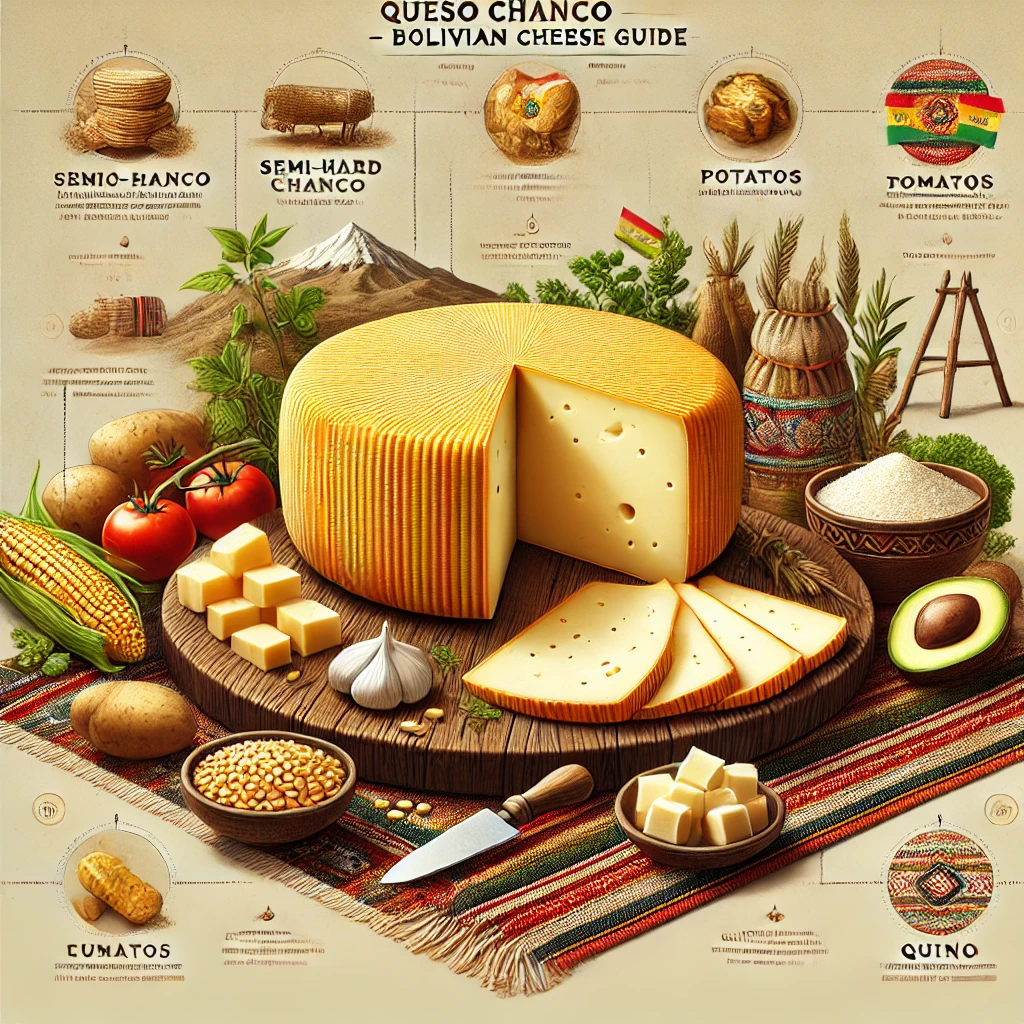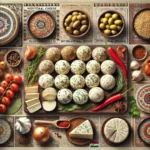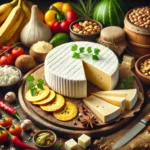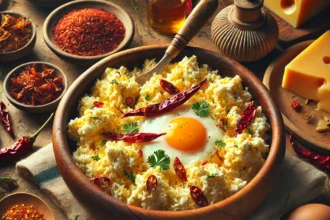Bolivia’s culinary heritage is defined by high-altitude crops, Andean livestock, and centuries of blending Spanish dairy techniques with Indigenous foodways. Among its most iconic dairy products stands Queso Chanco—a semi-hard cheese known for its salty bite, buttery undertone, and remarkable versatility. Though its variants appear throughout Chile and Peru, the Bolivian adaptation is distinctive, shaped by altitude, grass-fed cattle, and rural market culture.
Creamy yet firm, savoury yet balanced, Queso Chanco is a cheese that holds a unique position in Bolivia’s daily diet—from breakfast tables in Cochabamba to roadside anticucho stalls in La Paz.
🇧🇴 What Is Bolivian Queso Chanco?
Queso Chanco is a semi-hard, slightly elastic cheese traditionally made from cow’s milk. It is often lightly aged to achieve a flavour that is stronger than fresh queso fresco, but milder than sharp Andean mountain cheeses.
Key Characteristics
| Feature | Description |
|---|---|
| Texture | Semi-hard, sliceable, slightly elastic |
| Flavour | Salty, buttery, mild tang |
| Aroma | Light dairy, grassy from highland pastures |
| Aging | 10–45 days (sometimes longer) |
| Colour | Pale yellow to cream |
| Salting | Moderate to high |
Bolivia’s climate—cool highland evenings and crisp mornings—creates the perfect environment for slow, mild aging.
🏔 Where Queso Chanco Comes From
Though known across the Andes, Bolivian Queso Chanco is mostly produced in:
-
Cochabamba
-
Oruro
-
Chuquisaca
-
Tarija
-
rural valleys of Potosí
Why This Matters
Cows graze on:
-
wild grasses
-
alfalfa
-
natural forage
This terroir gives Chanco its fresh, meadow-like dairy profile unlike factory-standard cheeses.
🥛 How Queso Chanco Is Made
Production methods remain largely artisanal. Regional dairy cooperatives and home producers still rely on hand-pressed curds and low-additive technique.
Traditional Process
-
Raw Milk Heating
Milk is warmed to culture-friendly temperature. -
Coagulation with Rennet
Curds form slowly. -
Cutting the Curd
Curd is sliced into blocks to expel whey. -
Pressing
Light pressing forms a semi-hard body without over-drying. -
Salting
Brine or dry salt rub adds flavour and preservation. -
Aging
Wheels rest in cool cellars or open-air rooms—Bolivian style.
Minimal processing results in clean dairy flavour with salty Andean punch.
🍽 How Bolivians Eat Queso Chanco
Everyday Table Uses
-
breakfast cheese with bread (marraqueta & mate tea)
-
sliced in sandwiches
-
paired with jam or local honey
Classic Bolivian Dishes
| Dish | Role of Chanco |
|---|---|
| Salteñas | melted interior cheese accent |
| Sopa de Queso | core thickening and flavour |
| Api con Queso | sweet purple corn drink + pastry + cheese plate |
| Llajua with Cheese | spicy tomato dip balances salt |
| Ch’arki & Cheese Platters | bold salt pairing |
Street Food Usage
Queso Chanco is often grilled or lightly fried:
-
crispy outside
-
creamy inside
🧀 Texture & Taste Breakdown
Flavour Notes
-
buttery
-
grassy
-
mild acidity
-
subtle salt crystal aftertaste
Texture Feel
-
firm but not dry
-
melts with gentle stretch (not mozzarella-style)
-
slice-stable
It occupies a flavour territory between gouda and queso fresco.
🌍 How It Compares with Other Andean Cheeses
| Cheese | Similarity | Difference |
|---|---|---|
| Queso Fresco | mild dairy | Chanco is saltier + aged |
| Queso Andino | semi-hard | Chanco is more elastic |
| Chilean Chanco | same root style | Bolivian version is saltier + grassy |
| Cotija (Mexico) | salty edge | Cotija is crumbly + drier |
Bolivian Chanco stands apart because of altitude-based aging and pasture-fed dairy richness.
🍷 Beverage Pairing Guide
Best Pairings
| Pairing | Why It Works |
|---|---|
| Singani (Bolivian spirit) | citrus aromatics balance salt |
| Torrontés | floral freshness meets dairy mildness |
| Pale Lager | carbonation cuts buttery mouthfeel |
| Mate Cocido | traditional breakfast harmony |
Non-Alcoholic Pairings
-
Api morado (purple corn drink)
-
Mocochinchi (dried peach infusion)
Uniquely Bolivian combinations that celebrate local palette.
🌱 Nutritional Snapshot
Per 100g (approx.)
| Nutrient | Value |
|---|---|
| Calories | 260–330 |
| Protein | 20–24g |
| Fat | 18–22g |
| Sodium | moderate to high |
| Calcium | rich source |
Short aging and freshwater pasture milk give Chanco:
-
digestible fat structure
-
well-balanced salt-protein ratio
🌎 International Presence
Although not as globally distributed as mozzarella or feta, Queso Chanco is gaining attention in:
-
U.S. Andean specialty shops
-
Madrid and Barcelona Latin food markets
-
Chile-Peru-Bolivia cross-border trade
-
Toronto & São Paulo Latin grocery networks
Its biggest export ambassadors are Bolivian restaurants introducing api con queso and sopa de queso abroad.
⭐ Final Summary
Bolivian Queso Chanco is a cheese of:
-
mountain terroir
-
small dairy craft
-
salt-forward but buttery identity
-
breakfast-to-dinner flexibility
Where European cheeses lean on centuries of monastery control, Bolivian Chanco leans on family kitchens, valley dairies, and Andean rhythm. It is not just cheese—it is Bolivia’s comforting, culinary backbone.
FAQs — Queso Chanco
1. Is Queso Chanco the same as Chilean Chanco?
They share origins, but Bolivian Chanco is saltier, grassier, and lightly firmer due to altitude aging.
2. Does Chanco melt well?
Yes, though it doesn’t fully stretch—ideal for grilling, casseroles, and soups.
3. How long is it aged?
Typically 10–45 days, depending on region and salt treatment.
4. What milk is used?
Mostly cow’s milk from Andean pasture-fed herds.
5. What dishes best showcase it?
Api con queso, sopa de queso, salteñas, and grilled breakfast sandwiches.






